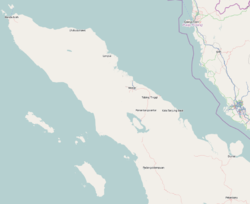| Indrapuri Old Mosque Meuseujid Tuha Indra Puri | |
|---|---|
 | |
| Religion | |
| Affiliation | Islam |
| Branch/tradition | Sunni |
| Region | Southeast Asia |
| Status | Active |
| Location | |
| Location | Indrapuri, Indonesia |
| Coordinates | 5°24′55″N95°26′48″E / 5.4154°N 95.4466°E |
| Architecture | |
| Type | Mosque |
| Style | Acehnese |
| Completed | between 1607 - 1636 [1] |
Indrapuri Old Mosque (Acehnese: Meuseujid Tuha Indra Puri, Indonesian: Masjid Tua Indrapuri) is a mosque in Indrapuri, Indonesia. Constructed in the early 17th-century, it is one of the oldest mosques in Aceh Province.











